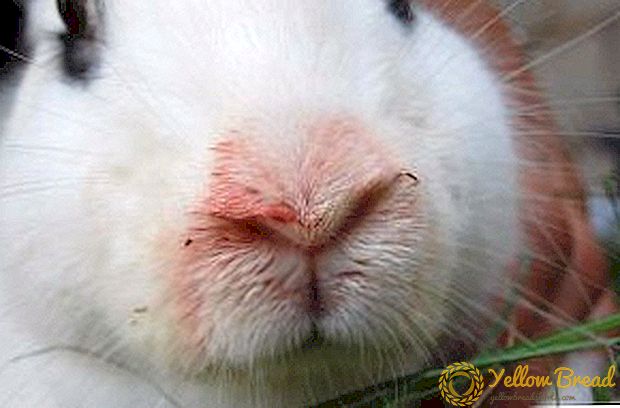 If you are breeding rabbits, you must carefully monitor their health. Quite often, animals are affected by a disease like pasteurellosis in rabbits, the symptoms of which will be described in this article.
If you are breeding rabbits, you must carefully monitor their health. Quite often, animals are affected by a disease like pasteurellosis in rabbits, the symptoms of which will be described in this article.
- Description of the disease
- Causes of
- Symptoms and course of the disease
- Sharp
- Chronic
- Diagnosis of the disease
- Is it possible to cure rabbits
- Preventive measures
Description of the disease
Pasteurellosis - one of the most dangerous infectious diseases. Its pathogen is Pasteurella wand. The disease affects the mucous membranes of the upper respiratory tract. It is possible to notice the first signs of an illness in 5-10 hours after a stick has entered the body. They are poorly expressed, therefore, it is rather difficult to determine the presence of the disease in the early stages.
The probability of death in the disease is 15-75%, depending on the conditions of animals and the food they eat. The external manifestation of rabbit pasteurellosis is shown in the photo.  With the defeat of the disease:
With the defeat of the disease:
- diarrhea begins and bowel distention occurs;
- breathing becomes heavy, is accompanied by wheezing;
- mucus is secreted from the nose and eyes;
- appetite worse;
- animal behavior is characterized by lethargy, indifference;
- body temperature rises to 41-42 degrees.
Infection with the disease can occur at any time of the year, striking rodents regardless of their age and breed. Juveniles are more susceptible.
Causes of
As mentioned above, infection occurs when Pasteurella sticks enter the body of an animal. Infection can spread cattle, pigs, sheep, chickens, geese and other animals. A person can also be a distributor - the wand is transferred onto clothing and footwear, with infected feed, inventory tools and equipment.
Reproduction in the body of Pasteurella occurs fairly quickly, they are penetrated into the lymphatic and circulatory systems, which leads to septicemia.Toxic products damage the vascular walls, hemorrhagic diathesis develops, swelling is observed.
Unfortunately, it is quite problematic to establish the exact cause of the disease, so it is recommended to regularly inspect animals and carry out preventive measures. 
Symptoms and course of the disease
There are two forms in which pasteurellosis usually occurs. Consider them in more detail.
Sharp
Most often the acute stage is observed in the beginning of the epizootic. During this period, rodents are usually subjected to stress, they are influenced by various adverse factors: unexpected and long-term transportation, changes in the conditions of care, regrouping.
First of all, the body temperature rises to 41 degrees, the animal refuses to eat, becomes weak, the symptoms of lesions of the upper respiratory tract appear, rabbits sneeze and a runny nose is observed. Often you can notice rapid and difficult breathing in animals.After a time, the defeat of the digestive tract occurs, diarrhea begins. The weakening of rodents is carried out rather quickly, and after 1-2 days their death occurs.
Chronic
At first, animals develop symptoms similar to those of rhinitis, conjunctivitis, and keratoconjunctivitis. There may also be diarrhea. Over time, fibrous and fibrous-purulent pleuropneumonia develops.
If rodents are kept in adverse conditions or are part of a dysfunctional herd, pneumonia spreads very quickly and leads to the death of all animals. In the subcutaneous tissue of some rabbits, it is sometimes possible to find purulent abscesses, the opening of which occurs after 1-3 months. 
Diagnosis of the disease
The diagnosis is made on the basis of clinical studies, as well as after the opening of the dead animals. The epizootic situation in the region is also carefully studied, the diagnosis is confirmed with the help of bacteriological studies of material taken from dead animals.
Is it possible to cure rabbits
If you start treatment in time, there is every chance to cure pets. However, the causative agent (wand) will still remain in the body, and the disease may flare up again.
- norsulfazole;
- neomycin;
- tetracycline;
- biomitsin;
- sulfadimezin;
- chloramphenicol;
- biomitsin.
The course of treatment with these drugs is 3-4 days, they must be administered intramuscularly twice a day.  If there is a chronic form of the disease, it is necessary to adhere to the following scheme: for the first three days to inject the sulfonamides, then 3 days of antibiotics and then again the sulfonamides. The general course of treatment is approximately 9-10 days.
If there is a chronic form of the disease, it is necessary to adhere to the following scheme: for the first three days to inject the sulfonamides, then 3 days of antibiotics and then again the sulfonamides. The general course of treatment is approximately 9-10 days.
Today, the "extract formol vaccine" is very common, but it can only be used for the treatment of baby rabbits, whose age is more than 1.5 months.For the treatment of animals whose age is 20-40 days, use serum, which is injected every 7 days at the rate of 4 ml per 1 kg of rabbit weight.
When pasteurellosis occurs in rabbits, it is necessary to immediately treat it, since the disease proceeds rather quickly and it is not possible to save the animals.
Treatment of rodents with severe damage is usually not carried out - they are killed and discarded so that the infection does not spread further.
Preventive measures
To prevent the spread of the disease, it is worth the following preventive measures:
- Inhibit infected rabbits into quarantine and immediately treat them;
- as soon as possible to identify what has become a source of infection, to carry out its elimination;
- clean and disinfect cells, enclosures, drinkers and adjacent areas. Releasing animals into their cages is possible only 2 weeks after treatment.
 Disinfection of animal housing is carried out by processing:
Disinfection of animal housing is carried out by processing:- 1% formalin solution;
- 3% solution of lysol;
- 3% solution carbolic acid;
- 2% solution of caustic soda.
These funds must be mixed in the same container and treated with a solution of the cage and other rooms where there are rabbits.
With the help of boiling water is carried out processing of feeders, drinking bowls, manure scrapers and other equipment. Since Pasteurella can be present in the manure, it is usually buried. 
Obligatory stage of preventive measures is the use of rabbit pasteurellosis vaccine. It begins to be used immediately, as rodents reach one month of age. Vaccination of adults is carried out 2 times a year. Today, there are a huge number of vaccination schemes, so before applying you should carefully read the instructions. The most common and effective are such drugs:
- "Pasorin-Ol";
- "Pestorin Mormix";
- "Formolvaccine".
Pasteurellosis is a rather serious disease, the probability of death after which is very high. With proper, careful care, as well as compliance with the rules of antiseptics and timely vaccination, you can prevent the death of animals.






